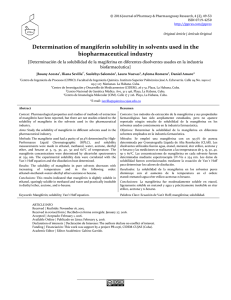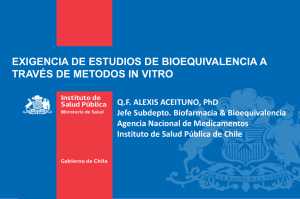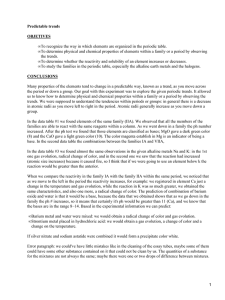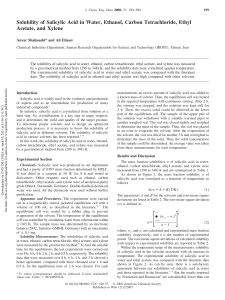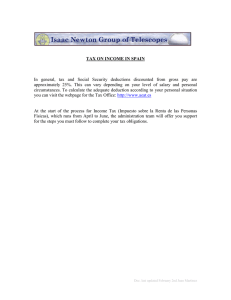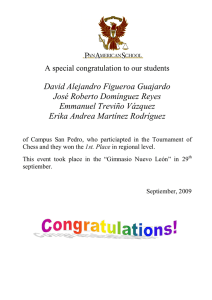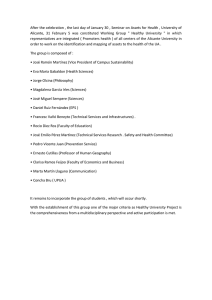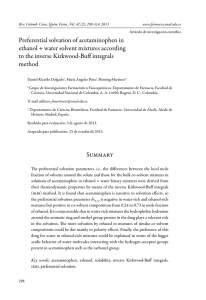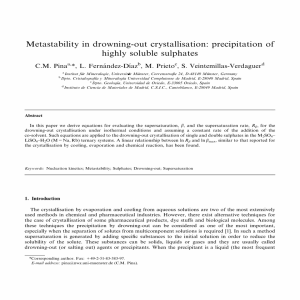Solubility of acetaminophen in polyethylene glycol 400 + water
Anuncio
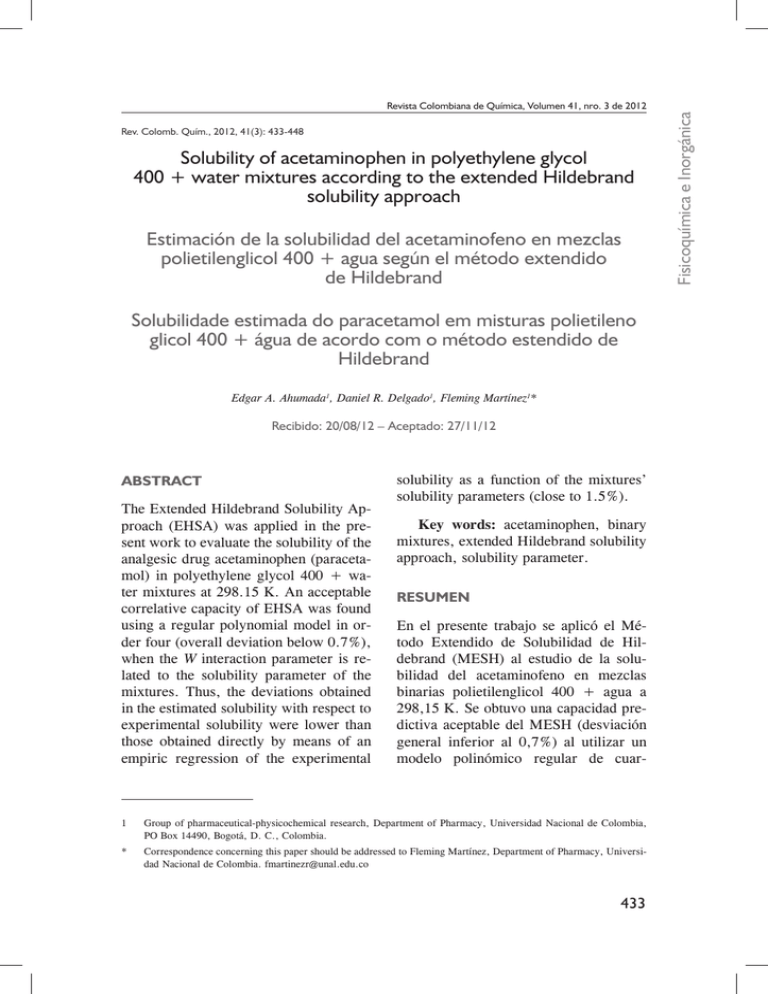
Rev. Colomb. Quím., 2012, 41(3): 433-448 Solubility of acetaminophen in polyethylene glycol 400 + water mixtures according to the extended Hildebrand solubility approach Estimación de la solubilidad del acetaminofeno en mezclas polietilenglicol 400 + agua según el método extendido de Hildebrand Solubilidade estimada do paracetamol em misturas polietileno glicol 400 + água de acordo com o método estendido de Hildebrand Edgar A. Ahumada1, Daniel R. Delgado1, Fleming Martínez1* Recibido: 20/08/12 – Aceptado: 27/11/12 Abstract The Extended Hildebrand Solubility Approach (EHSA) was applied in the present work to evaluate the solubility of the analgesic drug acetaminophen (paracetamol) in polyethylene glycol 400 + water mixtures at 298.15 K. An acceptable correlative capacity of EHSA was found using a regular polynomial model in order four (overall deviation below 0.7%), when the W interaction parameter is related to the solubility parameter of the mixtures. Thus, the deviations obtained in the estimated solubility with respect to experimental solubility were lower than those obtained directly by means of an empiric regression of the experimental solubility as a function of the mixtures’ solubility parameters (close to 1.5%). Key words: acetaminophen, binary mixtures, extended Hildebrand solubility approach, solubility parameter. Resumen En el presente trabajo se aplicó el Método Extendido de Solubilidad de Hildebrand (MESH) al estudio de la solubilidad del acetaminofeno en mezclas binarias polietilenglicol 400 + agua a 298,15 K. Se obtuvo una capacidad predictiva aceptable del MESH (desviación general inferior al 0,7%) al utilizar un modelo polinómico regular de cuar- 1 Group of pharmaceutical-physicochemical research, Department of Pharmacy, Universidad Nacional de Colombia, PO Box 14490, Bogotá, D. C., Colombia. * Correspondence concerning this paper should be addressed to Fleming Martínez, Department of Pharmacy, Universidad Nacional de Colombia. [email protected] 433 Fisicoquímica e Inorgánica Revista Colombiana de Química, Volumen 41, nro. 3 de 2012 Revista Colombiana de Química, Volumen 41, nro. 3 de 2012 to orden que relaciona el parámetro de interacción W con el parámetro de solubilidad de las mezclas solventes. Las desviaciones obtenidas en la solubilidad estimada fueron de menor magnitud que las obtenidas al calcular esta propiedad directamente, utilizando una regresión empírica regular del mismo orden de la solubilidad experimental del fármaco en función del parámetro de solubilidad de las mezclas disolventes (cerca del 1.5%). Palabras clave: acetaminofeno, Método Extendido de Solubilidad de Hildebrand, mezclas binarias, parámetro de solubilidad. Resumo O método estendido de solubilidade de Hildebrand (MESH) foi aplicado nesta pesquisa para avaliar a solubilidade do paracetamol em água de misturas binárias + polietileno glicol 400 em 298,15 K. Obteve-se boa capacidade preditiva com o MESH (desvio inferior a 0,7%) quando se utiliza um polinômio regular de quarta ordem do parâmetro de interação W com o parâmetro de solubilidade das misturas de solventes. Os desvios obtidos na solubilidade estimada foram inferiores do que os obtidos através do cálculo desta propriedade diretamente, utilizando uma regressão normal empírica da mesma ordem da solubilidade experimental da droga em função do parâmetro de solubilidade das misturas solventes (cerca de 1,5 %). Palavras-chave: acetaminofeno, Método estendido de solubilidade de Hildebrand, misturas binárias, parâmetro de solubilidade. 434 Introduction Acetaminophen (ACP, Figure 1) is a drug widely used as analgesic and antipyretic which physicochemical properties have not yet been studied throroughly (1). In particular, its solubility in aqueous media is very important in several processes associated to research and development during the design of homogeneous liquid dosage forms intended mainly for pediatric patients (2). It is important to note that cosolvency is the best technique used in pharmacy to increase drug solubility (3). On the other hand, it is clear that predictive methods of physicochemical properties of drugs, in particular its solubility, are very important for industrial pharmacists because they allow the optimization of design processes (4). NH-CO-CH3 OH Figure 1. Molecular structure of acetaminophen. For this reason, the present work presents a physicochemical study about the solubility prediction of ACP in binary mixtures conformed by polyethylene glycol 400 (PEG) and water. The study was made based on the Extended Hildebrand Solubility Approach (EHSA) (5). Thus, this work is a continuation of previous research on acetaminophen in ethanol + water (6), propylene glycol + water (7), and ethanol + propylene glycol (8) mixtures. It is important to take into consideration that the EHSA method has been widely used to study the solubility of a lot of pharmaceutical compounds (9-27). On the other hand, PEG is after ethanol and propylene glycol the most used cosolvent to develop liquid pharmaceutical dosage forms (28). Moreover, PEG is also employed to regulate product evaporation (29). Theoretical The real solubility (X2) of a solid solute in a liquid solution is calculated adequately by means of the expression: − log X 2 = ∆H fus (T fus − T ) 2.303RT fus T + log γ 2 [1] where, ∆Hfus is the fusion enthalpy of the solute, R is the gas constant, Tfus is the melting point of the solute, T is the absolute temperature of the solution, log γ2 is the non-ideality term. The γ2 term is the activity coefficient of the solute and it is determined experimentally. One method of calculating γ2 is the referent to regular solutions obtained from − log X 2 = ∆H fus (T fus − T ) 2.303RT fus T + V2φ12 (δ 1 − δ 2 )2 [2] 2.303RT where V2 is the partial molar volume of the solute, ϕ1 is the volume fraction of the solvent in the saturated solution, and δ1 and δ2 are the solubility parameters of solvent and solute, respectively. Pharmaceutical dissolutions deviate from predicted by the regular solutions theory. In this respect, Martin et al. developed the EHSA method (9-15). If the A term (defined as V2φ12 /( 2.303RT )) is introduced in the Eq. [2], the real solubility of drugs can be calculated from the expression ( ) − log X 2 = − log X 2id + A δ 12 + δ 22 − 2W [3] where the W term is equal to 2Kδ1δ2 (where, K is the Walker parameter). The W factor can be calculated from experimental data by means of log γ 2 W = 0.5 × δ 12 + δ 22 − A [4] where γ2 is the activity coefficient of the solute in the saturated solution, and it is id calculated as X 2 / X 2. The experimental values of the W parameter can be correlated by means of regression analysis by using regular polynomials as a function of δ1, as follows W = C 0 + C1δ 1 + C 2 δ 12 + C 3 δ 13 ..... + C n δ 1n [5] These empiric models can be used to estimate the drug solubility by means of back-calculation resolving this property from the specific W value obtained in the respective polynomial regression. Experimental Reagents and materials Acetaminophen (Paracetamol, N-Acetyl-p-aminophenol, CAS RN: 103-90-2) was in agreement with the quality requirements of the American Pharmacopeia, USP (30). Polyethylene glycol 400 from DOW Chemicals (PEG), distilled water with conductivity < 2 mS cm–1, and filter units from Millipore Corp. Swinnex®-13 were also used. 435 Fisicoquímica e Inorgánica Revista Colombiana de Química, Volumen 41, nro. 3 de 2012 Revista Colombiana de Química, Volumen 41, nro. 3 de 2012 Solvent mixtures preparation The PEG employed was maintained over molecular sieve (Merck Number 3, 0.3 nm in pore diameter) to obtain a dry solvent prior to preparing the solvent mixtures. All PEG + water solvent mixtures were prepared in quantities of 50.00 g by mass using an Ohaus Pioneer TM PA214 analytical balance, in mass fractions from 0.10 to 0.90 varying by 0.10. ic volume of the solvent, and ρsoln is the solution density (2). φVspc = m2 + m1 (1 − VE1 ρ soln ) [6] m2 ρ soln The ACP apparent molar volume is calculated by multiplying the φVspcvalue and the molar mass of the solute. Results and discussion Solubility determination An excess of ACP was added to each mixed solvent evaluated in stoppered dark glass flasks. Solid-liquid mixtures were placed on a thermostatic bath (Neslab RTE 10 Digital One Thermo Electron Company) kept at 298.15 K for at least 7 days to reach the saturation equilibrium. Once at equilibrium, supernatant solutions were filtered before analysis. ACP concentrations were determined by measuring UV-absorbance after appropriate gravimetric dilutions with water and interpolation from a previously constructed UV spectrophotometric calibration curve (UV/VIS BioMate 3 Thermo Electron Company spectrophotometer). Density of the saturated solutions was determined with a digital density meter (DMA 45 Anton Paar) according to the procedure described in the literature (31). Estimation of the volumetric contributions Apparent specific volumes (φVspc) of the drug were calculated according to Eq. [6], where, m2 and m1 are the masses of solute and solvent in the saturated solution, respectively, VE1 is the specif- 436 The information about polarity and volumetric behavior of PEG + water mixtures, as a function of the composition, is shown in Table 1. On the other hand, the reported ideal solubility for this drug is 2.602 × 10–2 in mole fraction (32). Table 1 also summarizes the ACP solubility expressed in molarity and mole fraction, the density of the solvent and saturated mixtures, the apparent molar volume of ACP, and the solvent volume fraction in the saturated solutions at 298.15 K. Figure 2 shows the experimental solubility and the calculated solubility by using the regular solution model as a function of the solubility parameter of solvent mixtures. From density values of cosolvent mixtures and saturated solutions, in addition to ACP solubility, the solvent volume fraction (ϕ1) and apparent molar volume of the solute (φ mol) of the drug V in the saturated mixtures, were calculated. These values are also presented in Table 1. Ultimately, the activity coefficients of ACP as decimal logarithms are also presented in Table 1. These values were calculated from experimental solubility val- Table 1. Solvent composition, Hildebrand solubility parameter of mixtures, ACP solubility expressed in molarity and in mole fraction, density of the solvent and the saturated mixtures, apparent molar volume of ACP, solvent volume fraction in the saturated solutions, and activity coefficient of ACP as decimal logarithm, at 298.15 K. ϕ PEG a δ1 / MPa1/2 ACP Mol L–1 %CV X2 ρ solvent / g cm–3 ρ satd soln / g cm–3 a φVmol3 / ϕ1 cm mol–1 log γ2 0.0000 47.80 0.103 1.88 E-3 0.18 0.9970 0.9997 125.6 0.9871 1.142 0.0898 45.58 0.167 3.35 E-3 0.79 1.0131 1.0173 124.6 0.9791 0.891 0.1817 43.31 0.266 5.91 E-3 0.87 1.0298 1.0361 123.9 0.9671 0.644 0.2757 40.99 0.425 1.07 E-2 0.45 1.0471 1.0563 123.7 0.9474 0.386 0.3719 38.61 0.640 1.87 E-2 0.42 1.0650 1.0762 125.5 0.9197 0.144 0.4704 36.18 0.956 3.35 E-2 0.58 1.0821 1.0963 126.0 0.8795 -0.109 0.5713 33.69 1.319 5.73 E-2 0.53 1.0971 1.1145 125.8 0.8341 -0.343 0.6745 31.14 1.613 9.01 E-2 0.72 1.1090 1.1296 124.8 0.7987 -0.539 0.7804 28.52 1.834 0.141 0.35 1.1164 1.1407 123.5 0.7734 -0.733 0.8888 25.85 1.907 0.221 0.20 1.1204 1.1477 122.2 0.7670 -0.930 1.0000 23.10 1.616 0.417 0.18 1.1224 1.1465 121.4 0.8039 -1.205 From Rodríguez et al. (33). 20.00 0.00 25.00 30.00 35.00 40.00 45.00 50.00 -2.00 -4.00 log X2 -6.00 -8.00 -10.00 -12.00 -14.00 -16.00 -18.00 -20.00 δ1 / MPa1/2 Figure 2. Experimental solubility (○) and calculated solubility according to the regular solutions model of Hildebrand (◊) of ACP as a function of the solubility parameter of the solvent mixtures at 298.15 K. 437 Fisicoquímica e Inorgánica Revista Colombiana de Química, Volumen 41, nro. 3 de 2012 Revista Colombiana de Química, Volumen 41, nro. 3 de 2012 ues and ideal solubility at 298.15 K (X2 = 2.602 x 10–2). In water rich mixtures, γ2 values were greater than unit because the experimental solubilities are lower than the ideal value but in PEG rich mixtures these values were below one. In order to calculate the W parameter, the solubility parameter of ACP (δ2) is required and for this reason it was calculated by using Fedors and Van Krevelen methods as showed in Table 2 (34) obtaining the value 27.3 MPa1/2 which is similar to that obtained experimentally in ethanol + water and ethanol (6) + propylene glycol mixtures (8), i.e. 28.0 MPa1/2. In the next calculations the experimental value was used. It is interesting that PEG, where the maximum drug solubility is obtained, has a lower δ value (23.1 MPa1/2) compared to ACP. This result demonstrates that the maximum solubility is not always obtained in mixtures where the solubility parameters of drug and solvent are coincident. Table 3 summarizes the parameters A, K, and W for ACP in PEG + water mixtures. Figure 3 shows that the variation of the W parameter with respect to the solubility parameter of solvent mixtures, presents deviation from linear behavior. W values were adjusted to regular polynomials in orders from 1 to 5 (Eq. 5). Table 4 summarizes the coefficients obtained in all the regular polynomials from degrees one to five, whereas the W values back-calculated by using the respective polynomials are presented in Table 5. It is clear that these values depend on the model used in the W back-calculation. Similar behaviors have been re- 438 ported in the literature for this drug and for several other compounds in different solvent mixtures (6-27). Table 6 summarizes the solubility values obtained by using the W values obtained by back-calculation from the polynomial models (Table 4) which are presented in Table 5. In the same way it was made previously (6-27) and because the best adjustment is being searched, the first criterion used to define the polynomial order of W term as function of δ1 was the fitting standard uncertainties obtained, which values were as follows, 30.4, 0.420, 0.282, 0.074, and 0.066 (Table 4), for orders one to five, respectively. As another comparison criterion, Table 6 also summarizes the percentages of difference between ACP experimental solubility and those calculated by using EHSA. It was found that the more complex the polynomial used, the better the agreement found between experimental and calculated solubility. The most important increment in concordance is obtained when going from order 1 to order 2 (From 2925 to 4.13%). It is important to note that for pharmaceutical purposes an uncertainty below 5% is useful for practical purposes but for academic purposes a better agreement is required. In this way, the best improvement is obtained going from 3rd to 4th degree, i.e. from 3.27 to 0.69%. Thereby, in the following calculations the model in order 4 was used, just as has been made earlier on (26, 27). Nevertheless, it is interesting that the mean deviation using a polynomial of order 5 (0.49%, Table 6) is almost the same obtained as mean in the experimental uncertainties obtained (0.50%, Table 1) Table 2. Application of group contribution method to estimate the molar volume, partial solubility parameters, and total Hildebrand solubility parameter of ACP. Fedors a Van Krevelen a Group Quantity V/ cm3 mol–1 Fd / J1/2 cm3/2 mol–1 Fp2 / J cm3 mol–2 Uh / J mol–1 –OH 1 10.0 210 5002 20000 >C=O 1 10.8 290 7702 2000 –NH– 1 4.5 160 2102 3100 Phenylene 1 52.4 1270 1102 0 –CH3 1 33.5 420 02 0 111.2 b 2350 899100 25100 δd c δp d δh e (2350/111.2) = 21.13 MPa1/2 ((899100)1/2/111.2) = 8.53 MPa1/2 (25100/111.2)1/2 = 15.02 MPa1/2 δT f (21,132 + 8.532 + 15.022)1/2 = 27.3 MPa1/2 Calculated according to values and procedures presented by Barton (34). b Molar volume. c Partial solubility parameter by dispersion forces. d Partial solubility parameter by dipolar forces. e Partial solubility parameter by hydrogen bonding. f Total solubility parameter. a Table 3. A, K, and W experimental parameters for ACP in PEG + water mixtures at 298.15 K. a δ1 / MPa1/2 100 A / cm3 J–1 K / J cm–3 a W expt / J cm–3 a 47.80 4.25994 0.568223 1521.021 45.58 4.15917 0.556353 1420.116 43.31 4.03337 0.545040 1321.969 40.99 3.86480 0.534579 1227.081 38.61 3.69406 0.525147 1135.548 36.18 3.39298 0.517311 1048.134 33.69 3.04575 0.511563 965.133 31.14 2.77110 0.508406 886.542 28.52 2.57233 0.509009 813.088 25.85 2.50179 0.514442 744.595 23.10 2.73008 0.526342 680.877 1 J cm–3 = 1 MPa 439 Fisicoquímica e Inorgánica Revista Colombiana de Química, Volumen 41, nro. 3 de 2012 Revista Colombiana de Química, Volumen 41, nro. 3 de 2012 Table 4. Coefficients and statistical parameters of regular polynomials in several orders of W as a function of solubility parameters of cosolvent mixtures free of ACP (equation [6]). Values in parentheses are the respective uncertainties. Coefficient or Parameter Polynomial order 1 2 3 4 5 C0 -154 (43) 460.4 (2.9) 429 (10) 295 (14) 184 (70) C1 34.1 (1.2) -2.22 (0.17) 0.6 (0.9) 16.7 (1.7) 33 (10) C2 - 0.5105 (0.0024) 0.427 (0.025) -0.28 (0.07) -1.3 (0.6) C3 - - 7.8 (2.4) E-4 1.44 (0.14) E-2 4.3 (1.8) E-2 C4 - - - -9.6 (1.0) E-5 -5.1 (2.5) E-4 - - - - 2.3 (1.4) E-6 0.9868 1.0000 1.0000 1.0000 1.0000 30.412 0.4200 0.2820 0.0737 0.0656 C5 Adj. r 2 Fit. Err. 1700.00 1500.00 W expt (J/cm3) 1300.00 1100.00 900.00 700.00 500.00 300.00 20.00 25.00 30.00 35.00 40.00 45.00 50.00 δ1/ MPa 1/2 Figure 3. W parameter as a function of the solubility parameter of the solvent mixtures at 298.15 K. 440 Fisicoquímica e Inorgánica Revista Colombiana de Química, Volumen 41, nro. 3 de 2012 Table 5. W parameters (J cm–3 a) calculated by using several polynomial models at 298.15 K. Polynomial order δ1 / MPa1/2 a 1 2 3 4 5 47.80 1475.361 1520.838 1521.260 1520.995 1521.021 45.58 1399.751 1419.981 1419.937 1420.159 1420.110 43.31 1322.412 1322.019 1321.738 1322.006 1321.989 40.99 1243.285 1227.234 1226.907 1226.998 1227.024 38.61 1162.308 1135.933 1135.701 1135.573 1135.610 36.18 1079.414 1048.443 1048.393 1048.142 1048.151 33.69 994.535 965.118 965.274 965.066 965.037 31.14 907.598 886.339 886.653 886.644 886.605 28.52 818.528 812.520 812.857 813.094 813.093 25.85 727.245 744.104 744.233 744.523 744.576 23.10 633.666 681.573 681.151 680.905 680.882 1 J cm–3 = 1 MPa Table 6. Calculated solubility of ACP by using the W parameters obtained from regression models in orders 1, 2, 3, 4 and 5, and difference percentages with respect to the experimental values at 298.15 K. δ1 / MPa1/2 X2 calculated 1 2 4 5 2 3 4 5 47.80 2.42 E-7 1.81 E-3 1.97 E-3 1.87 E-3 1.88 E-3 100 3.52 4.82 0.51 0.01 45.58 6.77 E-5 3.26 E-3 3.23 E-3 3.38 E-3 3.34 E-3 98 2.56 3.38 0.82 0.12 43.31 6.42 E-3 5.97 E-3 5.66 E-3 5.95 E-3 5.93 E-3 9 0.93 4.20 0.70 0.38 40.99 0.191 1.10 E-2 1.04 E-2 1.05 E-2 1.06 E-2 1689 2.76 3.06 1.48 1.01 38.61 1.773 2.00 E-2 1.92 E-2 1.88 E-2 1.89 E-2 9386 6.77 2.63 0.43 1.06 36.18 4.439 3.51 E-2 3.49 E-2 3.35 E-2 3.36 E-2 13164 4.95 4.13 0.13 0.27 33.69 3.542 5.72 E-2 5.84 E-2 5.68 E-2 5.65 E-2 6081 0.21 2.01 0.94 1.33 31.14 1.323 8.78 E-2 9.14 E-2 9.13 E-2 9.08 E-2 1369 2.55 1.43 1.31 0.81 28.52 0.268 0.132 0.137 0.141 0.141 90 6.50 2.70 0.07 0.06 25.85 3.00 E-2 0.209 0.212 0.220 0.221 86 5.50 4.09 0.83 0.23 23.10 1.10 E-3 0.455 0.432 0.419 0.418 100 9.15 3.51 0.36 0.07 2925 4.13 3.27 0.69 0.49 4572 2.70 1.02 0.45 0.48 Standard Deviation b 3 % dev. a Mean value b 1 Calculated as 100 ×X2 expt – X2 calc/X2 expt. b Calculated considering the obtained values in the neat solvents and the nine binary mixtures. a 441 Revista Colombiana de Química, Volumen 41, nro. 3 de 2012 As it has been described previously, an important consideration about the usefulness of the EHSA method is that which refers to justifying the complex calculations involving any other variables, instead of the simple empiric regression of the experimental solubility as a function of the solvent mixtures’ solubility parameters (Table 1, Figure 4). For this reason, in the Table 7 the experimental solubilities are confronted to those calculated directly by using a regular polynomial in order 4 of log X2 as a function of δ1 values (Equation [7], with adjusted determination coefficient r2 = 0.9998 and fitting standard uncertainty = 0.0111) and also to those calculated involving the W parameters obtained from Eq. [5] adjusted to order 4 (Tables 4 and 5). The respective difference percentages are also presented in Table 7. log X 2 = 11.8(2.1) − 1.34(0.25)δ 1 + 5.5(1.1) × 10 −2 δ 12 −[7] 1.06(0.21) × 10 −3 δ 13 + 7.3(1.5) × 10 −6 δ 14 Table 7. Comparison of the ACP solubility values calculated directly and by using the EHSA at 298.15 K. % dev. a X2 δ1 / MPa1/2 Exptl. Calc. direct. b Calc. W c Calc. direct. Calc. W 47.80 1.878 E-3 1.91 E-3 1.87 E-3 1.49 0.51 45.58 3.348 E-3 3.26 E-3 3.38 E-3 2.54 0.82 43.31 5.910 E-3 5.88 E-3 5.95 E-3 0.57 0.70 40.99 1.070 E-2 1.07 E-2 1.05 E-2 0.36 1.48 38.61 1.869 E-2 1.93 E-2 1.88 E-2 3.45 0.43 36.18 3.347 E-2 3.36 E-2 3.35 E-2 0.37 0.13 33.69 5.730 E-2 5.58 E-2 5.68 E-2 2.60 0.94 31.14 9.010 E-2 8.92 E-2 9.13 E-2 1.05 1.31 28.52 0.141 0.140 0.141 0.37 0.07 25.85 0.221 0.228 0.220 2.92 0.83 23.10 0.417 0.412 0.419 Mean value d Standard Deviation d 1.23 0.36 1.54 0.69 1.14 0.45 Calculated as 100 ×X2 expt – X2 calc/X2 expt. Calculated using Eq [5] adjusted to order 4 (Table 3). Calculated using Eq. [7]. d Calculated considering the obtained values in the neat solvents and the nine binary mixtures. a b c Based on mean deviation percentages presented in Table 6 (1.54% and 0.69% for direct calculation and EHSA method, respectively) it follows that a slight difference is found between the values obtained by using both methods. As it has happened for several drugs, the present 442 results show a significant usefulness of the EHSA method for practical and academic purposes, in particular, if differences below 1% are required. On the other hand, it is very interesting that this drug mainly exhibits posi- 20.00 25.00 30.00 35.00 40.00 45.00 Fisicoquímica e Inorgánica Revista Colombiana de Química, Volumen 41, nro. 3 de 2012 50.00 0.00 -0.50 log X2 -1.00 -1.50 -2.00 -2.50 -3.00 δ1/ MPa1/2 Figure 4. Logarithmic solubility of ACP as a function of the solubility parameter of the solvent mixtures at 298.15 K. Dotted line is the additive solubility behavior. tive deviations with respect to the ideal log-linear additive model proposed by Yalkowsky and Roseman (dotted line in Figure 4) (3). This behavior is different compared to those observed by Rubino and Obeng (35) who found negative deviations in water-rich mixtures and positive deviations in propylene glycol-rich mixtures by studying the solubility of homologous series of some alkyl p-hydroxybenzoates and p-aminobenzoates. It is also different compared to those reported for ibuprofen, naproxen, ketoprofen, and indomethacin in the similar cosolvent mixtures (36-40) where negative and positive deviations were also found in water-rich and cosolvent-rich mixtures, respectively. The results for ACP in PEG mixtures could be attributed to a better solvation of the drug by the cosolvent molecules by means of hydrogen bonding where the phenolic hydroxyl group of ACP would be interacting with the ether groups of PEG. Conclusion The EHSA method has been adequately used in the present work to study the solubility of acetaminophen in PEG + water mixtures by using experimental values of molar volume and Hildebrand solubility parameter of this analgesic drug. In particular, a good predictive character has been found by using a regular polynomial in order four of the interaction parameter W as a function of the solubility parameter of solvent mixtures free of solute. In this way, the predictive character of EHSA is better than that obtained by direct correlation between solubility and mixtures composition. Acknowledgements The authors wish to thank the Department of Pharmacy of the Universidad Nacional de Colombia for facilitating the use of equipment and facilities used in this research work. 443 Revista Colombiana de Química, Volumen 41, nro. 3 de 2012 References 1. Raffa, R. B. Analgesic, antipyretic, and anti-inflammatory drugs. In: Remington: The Science and Practice of Pharmacy. 21 ed. A. Gennaro (ed). Philadelphia: Lippincott Williams & Wilkins. 2005. pp. 15241542. 2. Jiménez, J. A.; Martínez, F. Thermodynamic study of the solubility of acetaminophen in propylene glycol + water cosolvent mixtures. J. Braz. Chem. Soc. 2006. 17: 125134. 3. Yalkowsky, S. H.; Roseman, T. J. Solubilization of drugs by cosolvents. In: Techniques of Solubilization of Drugs. S. H. Yalkowsky (ed). New York: Marcel Dekker, Inc. 1981. pp. 91-134. 4. Jouyban, A. Handbook of Solubility Data for Pharmaceuticals. Boca Raton, FL: CRC Press, Taylor & Francis Group. 2010. pp. 30-58. 5. Martin, A.; Bustamante, P.; Chun, A. H. C. Physical Chemical Principles in the Pharmaceutical Sciences. 4 ed. Philadelphia: Lea & Febiger, 1993. 6. Romero, S.; Reillo, A.; Escalera, B.; Bustamante, P. The behavior of paracetamol in mixtures of amphiprotic and amphiprotic-aprotic solvents: Relationship of solubility curves to specific and nonspecific interactions. Chem. Pharm. Bull. 1996. 44: 1061-1064. 444 7. Martínez, F. Utilidad del método extendido de Hildebrand en el estudio de la solubilidad del acetaminofén en mezclas agua-propilenoglicol. Rev. Acad. Colomb. Cienc. 2005. 29: 429-438. 8. Martínez, F. Aplicación del método extendido de Hildebrand al estudio de la solubilidad del acetaminofén en mezclas etanol-propilenoglicol. Acta Farm. Bonaerense 2005. 24: 215-224. 9. Martin, A.; Newburger, J.; Adjei, A. Extended Hildebrand approach: Solubility of caffeine in dioxane-water mixtures. J. Pharm. Sci. 1980. 69: 659-661. 10. Martin, A.; Carstensen, J. Extended solubility approach: Solubility parameters for crystalline solid compounds. J. Pharm. Sci. 1981. 70: 170-172. 11. Martin, A.; Paruta, A. N.; Adjei, A. Extended Hildebrand Solubility Approach: Methylxanthines in mixed solvents. J. Pharm. Sci. 1981. 70: 1115-1115. 12. Martin, A.; Miralles, M. J. Extended Hildebrand solubility approach: Solubility of tolbutamide, acetohexamide, and sulfisomidine in binary solvent mixtures. J. Pharm. Sci. 1982. 71: 439-442. 13. Martin, A.; Wu, P. L.; Adjei, A.; Mehdizadeh, M.; James, K. C.; Metzler, C. Extended Hildebrand solubility approach: testosterone and testosterone propionate in binary solvents. J. Pharm. Sci. 1982. 71: 1334-1340. etilo + etanol. Rev. Colomb. Quím. 2009. 38: 235-247. 14. Martin, A.; Wu, P. L. Extended Hildebrand solubility approach: pHydroxybenzoic acid in mixtures of dioxane and water. J. Pharm. Sci. 1983. 72: 587-592. 20. Rathi, P. B. Prediction of satranidazole solubility in water-polyethylene glycol 400 mixtures using extended Hildebrand solubility approach. Iranian J. Pharm. Sci. 2010. 7, 17-24. 15. Martin, A.; Wu, P. L.; Velasquez, T. Extended Hildebrand solubility approach: sulfonamides in binary and ternary solvents. J. Pharm. Sci. 1985. 74: 277-282. 21. Gantiva, M.; Martínez, F. Método extendido de Hildebrand en la predicción de la solubilidad del ketoprofeno en mezclas cosolventes etanol + agua. Quím. Nova 2010. 33: 370-376. 16. Jouyban-Gharamaleki, A.; Acree Jr., W. E. Comment concerning: solubility prediction of caffeine in aqueous N,N-dimethylformamide mixtures using the extended Hildebrand solubility approach. Int. J. Pharm. 1999. 177: 127-128. 17. Pacheco, D. P.; Manrique, Y. J.; Vargas, E. F.; Barbosa, H. J.; Martínez, F. Validez del método extendido de Hildebrand en la predicción de las solubilidades de ibuprofén y naproxén en mezclas propilenoglicol-etanol. Rev. Colomb. Quím. 2007. 36: 55-72. 18. Aragón, D. M.; Pacheco, D. P.; Ruidiaz, M. A.; Sosnik, A. D.; Martínez, F. Método extendido de Hildebrand en la predicción de la solubilidad de naproxeno en mezclas cosolventes etanol + agua. Vitae, Rev. Fac. Quím. Farm. 2008. 15: 113-122. 19. Ruidiaz, M. A.; Martínez, F. Método extendido de Hildebrand en la estimación de la solubilidad de la indometacina en mezclas acetato de 22. Rodríguez, S. J.; Cristancho, D. M.; Neita, P. C.; Vargas, E. F.; Martínez, F. Extended Hildebrand solubility approach in the solubility estimation of the sunscreen ethylhexyl triazone in ethyl acetate + ethanol mixtures. Lat. Am. J. Pharm. 2010. 29: 1113-1119. 23. Ruidiaz, M. A.; Delgado, D. R.; Mora, C. P.; Yurquina, A.; Martínez, F. Estimation of the indomethacin solubility in ethanol + water mixtures by the extended Hildebrand solubility approach. Rev. Colomb. Cienc. Quím. Farm. 2010. 39: 79-95. 24. Rathi, P. B.; Mourya, V. K. Extended Hildebrand solubility approach: Satranidazole in mixtures of dioxane and water. Indian J. Pharm. Sci. 2011. 73: 315-319. 25. Rathi, P. B. Prediction of satranidazole solubility in water-polyethylene glycol 400 mixtures using Extended Hildebrand Solubility Approach. 445 Fisicoquímica e Inorgánica Revista Colombiana de Química, Volumen 41, nro. 3 de 2012 Revista Colombiana de Química, Volumen 41, nro. 3 de 2012 Iranian J. Pharm. Sci. 2011. 7, 1724. ganic and aqueous solvents. Phys. Chem. Liq. 2004. 42: 603-613. 26. Ruidiaz, M. A.; Delgado, D. R.; Martínez, F. Extended Hildebrand solubility approach to correlate the indomethacin solubility in 1,4-dioxane + water mixtures. Quím. Nova 2011. 34: 1569-1574. 33. Rodríguez, G. A.; Holguín, A. R.; Martínez, F.; Khoubnasabjafari, M.; Jouyban, A. Volumetric properties of (PEG 400 + water) and (PEG 400 + ethanol) mixtures at several temperatures and correlation with the Jouyban-Acree model. Lat. Am. J. Pharm. 2012. Submitted. 27. Holguín, A. R.; Delgado, D. R.; Martínez, F. Indomethacin solubility in propylene glycol + water mixtures according to the extended Hildebrand solubility approach. Lat. Am. J. Pharm. 2012. 31: 720-726. 34. Barton, A. Handbook of Solubility Parameters and Other Cohesion Parameters. 2nd ed. New York: CRC Press, 1991, pp. 157-193. 28. Rubino, J. T. Cosolvents and cosolvency. In: Encyclopedia of Pharmaceutical Technology. Vol 3. J. Swarbrick; J.C. Boylan (eds). New York: Marcel Dekker, Inc. 1988. pp. 375-398. 35. Rubino, J. T.; Obeng, E. K. Influence of solute structure on deviations from the log-linear solubility equation in propylene glycol - water mixtures. J. Pharm. Sci. 1991. 80: 479-483. 29. Aulton, M. E. Pharmaceutics, The Science of Dosage Forms Design. 2 ed. London: Churchill Livingstone. 2002. 36. Vargas, E. F.; Manrique, Y. J.; Pacheco, D. P.; Torres, N. S.; Martínez, F. Desviaciones al modelo logarítmico-lineal en la solubilidad de ibuprofén y naproxén en mezclas cosolventes propilenoglicol-agua. Quím. Nova 2007. 30: 1945-1950. 30. US Pharmacopeia. 23 ed. Rockville, MD: United States Pharmacopeial Convention, 1994. 31. Rodríguez, S. J.; Cristancho, D. M.; Neita, P. C.; Vargas, E. F.; Martínez, F. Volumetric properties of the octyl methoxycinnamate + ethyl acetate solvent system at several temperatures. Phys. Chem. Liq. 2010. 48: 638-647. 32. Baena, Y.; Pinzón, J. A.; Barbosa, H.; Martínez, F. Temperature dependence of the solubility of some acetanilide derivatives in several or- 446 37. Vargas, E.; Sosnik, A.; Martínez, F. Aplicación del modelo de Jouyban-Acree para la estimación de la solubilidad del naproxeno en mezclas cosolventes etanol + agua. Lat. Am. J. Pharm. 2008. 27: 654-660. 38. Gantiva, M.; Vargas, E. F.; Manzur, M. E.; Yurquina, A.; Martínez, F. Modelos de Yalkowsky-Roseman y Jouyban-Acree en la estimación de la solubilidad del ketoprofeno en algunas mezclas cosolventes propi- lenoglicol + agua. Rev. Colomb. Cienc. Quím. Farm. 2009. 38: 156171. 39. Gantiva, M., Yurquina, A., Martínez, F. Desempeño de los modelos de Yalkowsky & Roseman y de Jouyban & Acree en la estimación de la solubilidad del ketoprofeno en mezclas cosolventes etanol + agua. Vitae, Rev. Fac. Quím. Farm. 2009. 16: 361-368. 40. Ruidiaz, M. A.; Delgado, D. R.; Martínez, F. Performance of the Jouyban-Acree and Yalkowsky-Roseman models for estimating the solubility of indomethacin in ethanol + water mixtures. Rev. Acad. Colomb. Cienc. 2011. 35: 329-336. 447 Fisicoquímica e Inorgánica Revista Colombiana de Química, Volumen 41, nro. 3 de 2012
